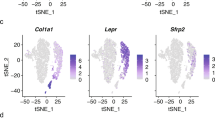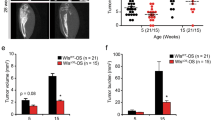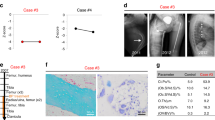Abstract
Ossifying fibroma (OF) is a rare benign tumor of the craniofacial bones that can reach considerable and disfiguring dimensions if left untreated. Although the clinicopathological characteristics of OF are well established, the underlying etiology has remained largely unknown. Our work indicates that Men1—a tumor suppressor gene responsible of Multiple endocrine neoplasia type 1—is critical for OF formation and shows that mice with targeted disruption of Men1 in osteoblasts (Men1Runx2Cre) develop multifocal OF in the mandible with a 100% penetrance. Using lineage-tracing analysis, we demonstrate that loss of Men1 arrests stromal osteoprogenitors in OF at the osterix-positive pre-osteoblastic differentiation stage. Analysis of Men1-lacking stromal spindle cells isolated from OF (OF-derived MSCs (OFMSCs)) revealed a downregulation of the cyclin-dependent kinase (CDK) inhibitor Cdkn1a, consistent with an increased proliferation rate. Intriguingly, the re-expression of Men1 in Men1-deficient OFMSCs restored Cdkn1a expression and abrogated cellular proliferation supporting the tumor-suppressive role of Men1 in OF. Although our work presents the first evidence of Men1 in OF development, it further provides the first genetic mouse model of OF that can be used to better understand the molecular pathogenesis of these benign tumors and to potentially develop novel treatment strategies.
This is a preview of subscription content, access via your institution
Access options
Subscribe to this journal
Receive 50 print issues and online access
$259.00 per year
only $5.18 per issue
Buy this article
- Purchase on Springer Link
- Instant access to full article PDF
Prices may be subject to local taxes which are calculated during checkout







Similar content being viewed by others
References
Liu Y, Wang H, You M, Yang Z, Miao J, Shimizutani K et al. Ossifying fibromas of the jaw bone: 20 cases. Dentomaxillofac Radiol 2010; 39: 57–63.
Woo SB . Central cemento-ossifying fibroma: primary odontogenic or osseous neoplasm? J Oral Maxillofac Surg 2015; 73: S87–S93.
El-Mofty SK NB, Toyosawa S . Ossifying fibroma. In: El-Naggar AK CJ, Grandis JR, Takata T, Slootweg PJ (eds). WHO Classification of Head and Neck Tumours. IARC Press, 2017, pp 251–252.
Franco-Barrera MJ, Zavala-Cerna MG, Fernández-Tamayo R, Vivanco-Pérez I, Fernández-Tamayo NM, Torres-Bugarín O . An update on peripheral ossifying fibroma: case report and literature review. Oral Maxillofac Surg 2016; 20: 1–7.
Waldron CA, Giansanti JS . Benign fibro-osseous lesions of the jaws: a clinical-radiologic-histologic review of sixty-five cases. II. Benign fibro-osseous lesions of periodontal ligament origin. Oral Surg Oral Med Oral Pathol 1973; 35: 340–350.
Trijolet JP, Parmentier J, Sury F, Goga D, Mejean N, Laure B . Cemento-ossifying fibroma of the mandible. Eur Ann Otorhinolaryngol Head Neck Dis 2011; 128: 30–33.
Qin H, Qu C, Yamaza T, Yang R, Lin X, Duan XY et al. Ossifying fibroma tumor stem cells are maintained by epigenetic regulation of a TSP1/TGF-beta/SMAD3 autocrine loop. Cell Stem Cell 2013; 13: 577–589.
Toyosawa S, Yuki M, Kishino M, Ogawa Y, Ueda T, Murakami S et al. Ossifying fibroma vs fibrous dysplasia of the jaw: molecular and immunological characterization. Mod Pathol 2007; 20: 389–396.
Falchetti A, Marini F, Luzi E, Giusti F, Cavalli L, Cavalli T et al. Multiple endocrine neoplasia type 1 (MEN1): not only inherited endocrine tumors. Genet Med 2009; 11: 825–835.
Chandrasekharappa SC, Guru SC, Manickam P, Olufemi SE, Collins FS, Emmert-Buck MR et al. Positional cloning of the gene for multiple endocrine neoplasia-type 1. Science 1997; 276: 404–407.
Lemmens I, Van de Ven WJ, Kas K, Zhang CX, Giraud S, Wautot V et al. Identification of the multiple endocrine neoplasia type 1 (MEN1) gene. The European Consortium on MEN1. Hum Mol Genet 1997; 6: 1177–1183.
Matkar S, Thiel A, Hua X . Menin: a scaffold protein that controls gene expression and cell signaling. Trends Biochem Sci 2013; 38: 394–402.
Schnepp RW, Chen YX, Wang H, Cash T, Silva A, Diehl JA et al. Mutation of tumor suppressor gene Men1 acutely enhances proliferation of pancreatic islet cells. Cancer Res 2006; 66: 5707–5715.
Kottemann MC, Bale AE . Characterization of DNA damage-dependent cell cycle checkpoints in a menin-deficient model. DNA Rep 2009; 8: 944–952.
Kanazawa I, Canaff L, Abi Rafeh J, Angrula A, Li J, Riddle RC et al. Osteoblast menin regulates bone mass in vivo. J Biol Chem 2015; 290: 3910–3924.
Liu P, Lee S, Knoll J, Rauch A, Ostermay S, Luther J et al. Loss of menin in osteoblast lineage affects osteocyte-osteoclast crosstalk causing osteoporosis. Cell Death Differ 2017; 24: 672–682 1-11.
Bertolino P, Tong WM, Herrera PL, Casse H, Zhang CX, Wang ZQ . Pancreatic beta-cell-specific ablation of the multiple endocrine neoplasia type 1 (MEN1) gene causes full penetrance of insulinoma development in mice. Cancer Res 2003; 63: 4836–4841.
Rauch A, Seitz S, Baschant U, Schilling AF, Illing A, Stride B et al. Glucocorticoids suppress bone formation by attenuating osteoblast differentiation via the monomeric glucocorticoid receptor. Cell Metab 2010; 11: 517–531.
Rodda SJ, McMahon AP . Distinct roles for Hedgehog and canonical Wnt signaling in specification, differentiation and maintenance of osteoblast progenitors. Development 2006; 133: 3231–3244.
Fauquier T, Chatonnet F, Picou F, Richard S, Fossat N, Aguilera N et al. Purkinje cells and Bergmann glia are primary targets of the TRalpha1 thyroid hormone receptor during mouse cerebellum postnatal development. Development 2014; 141: 166–175.
Srinivas S, Watanabe T, Lin CS, William CM, Tanabe Y, Jessell TM et al. Cre reporter strains produced by targeted insertion of EYFP and ECFP into the ROSA26 locus. BMC Dev Biol 2001; 1: 4.
Bhasin M, Bhasin V, Bhasin A . Peripheral ossifying fibroma. Case Rep Dent 2013; 2013: 497234.
Seo BM, Miura M, Gronthos S, Bartold PM, Batouli S, Brahim J et al. Investigation of multipotent postnatal stem cells from human periodontal ligament. Lancet 2004; 364: 149–155.
Karnik SK, Hughes CM, Gu X, Rozenblatt-Rosen O, McLean GW, Xiong Y et al. Menin regulates pancreatic islet growth by promoting histone methylation and expression of genes encoding p27Kip1 and p18INK4c. Proc Natl Acad Sci USA 2005; 102: 14659–14664.
Milne TA, Hughes CM, Lloyd R, Yang Z, Rozenblatt-Rosen O, Dou Y et al. Menin and MLL cooperatively regulate expression of cyclin-dependent kinase inhibitors. Proc Natl Acad Sci USA 2005; 102: 749–754.
Houlihan DD, Mabuchi Y, Morikawa S, Niibe K, Araki D, Suzuki S et al. Isolation of mouse mesenchymal stem cells on the basis of expression of Sca-1 and PDGFR-alpha. Nat Protoc 2012; 7: 2103–2111.
Eversole R, Su L, ElMofty S . Benign fibro-osseous lesions of the craniofacial complex. A review. Head Neck Pathol 2008; 2: 177–202.
Ramaesh T, Bard JB . The growth and morphogenesis of the early mouse mandible: a quantitative analysis. J Anat 2003; 203: 213–222.
Yang YJ, Song TY, Park J, Lee J, Lim J, Jang H et al. Menin mediates epigenetic regulation via histone H3 lysine 9 methylation. Cell Death Dis 2013; 4: e583.
Zhang H, Zhao X, Zhang Z, Chen W, Zhang X . An immunohistochemistry study of Sox9, Runx2, and Osterix expression in the mandibular cartilages of newborn mouse. Biomed Res Int 2013; 2013: : 265380.
Papagerakis P, Mitsiadis T . Ch.109. Development and Structure of Teeth and Periodontal Tissues, 8th edn. John Wiley & Sons Inc.: Danvers, USA, 2013.
Shibata S, Yokohama-Tamaki T . An in situ hybridization study of Runx2, Osterix, and Sox9 in the anlagen of mouse mandibular condylar cartilage in the early stages of embryogenesis. J Anat 2008; 213: 274–283.
Engleka KA, Wu M, Zhang M, Antonucci NB, Epstein JA . Menin is required in cranial neural crest for palatogenesis and perinatal viability. Dev Biol 2007; 311: 524–537.
Joyce JA, Pollard JW . Microenvironmental regulation of metastasis. Nat Rev Cancer 2009; 9: 239–252.
Bianco P, Robey PG, Simmons PJ . Mesenchymal stem cells: revisiting history, concepts, and assays. Cell Stem Cell 2008; 2: 313–319.
Park D, Spencer JA, Koh BI, Kobayashi T, Fujisaki J, Clemens TL et al. Endogenous bone marrow MSCs are dynamic, fate-restricted participants in bone maintenance and regeneration. Cell Stem Cell 2012; 10: 259–272.
Sung JH, Yang HM, Park JB, Choi GS, Joh JW, Kwon CH et al. Isolation and characterization of mouse mesenchymal stem cells. Transplant Proc 2008; 40: 2649–2654.
Morikawa S, Mabuchi Y, Kubota Y, Nagai Y, Niibe K, Hiratsu E et al. Prospective identification, isolation, and systemic transplantation of multipotent mesenchymal stem cells in murine bone marrow. J Exp Med 2009; 206: 2483–2496.
Omatsu Y, Sugiyama T, Kohara H, Kondoh G, Fujii N, Kohno K et al. The essential functions of adipo-osteogenic progenitors as the hematopoietic stem and progenitor cell niche. Immunity 2010; 33: 387–399.
Mendez-Ferrer S, Michurina TV, Ferraro F, Mazloom AR, Macarthur BD, Lira SA et al. Mesenchymal and haematopoietic stem cells form a unique bone marrow niche. Nature 2010; 466: 829–834.
Zhou BO, Yue R, Murphy MM, Peyer JG, Morrison SJ . Leptin-receptor-expressing mesenchymal stromal cells represent the main source of bone formed by adult bone marrow. Cell Stem Cell 2014; 15: 154–168.
Worthley DL, Churchill M, Compton JT, Tailor Y, Rao M, Si Y et al. Gremlin 1 identifies a skeletal stem cell with bone, cartilage, and reticular stromal potential. Cell 2015; 160: 269–284.
Ono N, Ono W, Nagasawa T, Kronenberg HM . A subset of chondrogenic cells provides early mesenchymal progenitors in growing bones. Nat Cell Biol 2014; 16: 1157–U1173.
Chan CKF, Seo EY, Chen JY, Lo D, McArdle A, Sinha R et al. Identification and specification of the mouse skeletal stem cell. Cell 2015; 160: 285–298.
Pinho S, Lacombe J, Hanoun M, Mizoguchi T, Bruns I, Kunisaki Y et al. PDGFRalpha and CD51 mark human nestin+ sphere-forming mesenchymal stem cells capable of hematopoietic progenitor cell expansion. J Exp Med 2013; 210: 1351–1367.
Mizoguchi T, Pinho S, Ahmed J, Kunisaki Y, Hanoun M, Mendelson A et al. Osterix marks distinct waves of primitive and definitive stromal progenitors during bone marrow development. Dev Cell 2014; 29: 340–349.
Kim YS, Burns AL, Goldsmith PK, Heppner C, Park SY, Chandrasekharappa SC et al. Stable overexpression of MEN1 suppresses tumorigenicity of RAS. Oncogene 1999; 18: 5936–5942.
Darling TN, Skarulis MC, Steinberg SM, Marx SJ, Spiegel AM, Turner M . Multiple facial angiofibromas and collagenomas in patients with multiple endocrine neoplasia type 1. Arch Dermatol 1997; 133: 853–857.
Yadav R, Gulati A . Peripheral ossifying fibroma: a case report. J Oral Sci 2009; 51: 151–154.
Isakov O, Rinella ES, Olchovsky D, Shimon I, Ostrer H, Shomron N et al. Missense mutation in the MEN1 gene discovered through whole exome sequencing co-segregates with familial hyperparathyroidism. Genet Res 2013; 95: 114–120.
Jackson CE, Norum RA, Boyd SB, Talpos GB, Wilson SD, Taggart RT et al. Hereditary hyperparathyroidism and multiple ossifying jaw fibromas: a clinically and genetically distinct syndrome. Surgery 1990; 108: 1006–1012, discussion 1012-1003.
Kassem M, Zhang X, Brask S, Eriksen EF, Mosekilde L, Kruse TA . Familial isolated primary hyperparathyroidism. Clin Endocrinol 1994; 41: 415–420.
Dempster DW, Compston JE, Drezner MK, Glorieux FH, Kanis JA, Malluche H et al. Standardized nomenclature, symbols, and units for bone histomorphometry: a 2012 update of the report of the ASBMR Histomorphometry Nomenclature Committee. J Bone Miner Res 2013; 28: 2–17.
Yamaza T, Ren G, Akiyama K, Chen C, Shi Y, Shi S . Mouse mandible contains distinctive mesenchymal stem cells. J Dent Res 2011; 90: 317–324.
Pfaffl MW . A new mathematical model for relative quantification in real-time RT-PCR. Nucleic Acids Res 2001; 29: e45.
Gherardi S, Ripoche D, Mikaelian I, Chanal M, Teinturier R, Goehrig D et al. Menin regulates Inhbb expression through an Akt/Ezh2-mediated H3K27 histone modification. Biochim Biophys Acta 2017; 1860: 427–437.
Acknowledgements
We are grateful to the staff of the animal facilities of the University of Ulm, led by Dr Petra Kirsch and in particular to Tobias Rappold. We thank Professor Dr Volker Rasche from the Core Facility Animal MRI, Ulm University and Dr Markus Rojewsky from the Institut für Transfusionsmedizin Universitätsklinikum Ulm. We thank Dr Merle Stein and Dr Giorgio Caratti for critical reading of the manuscript. This study was supported by the Boehringer Ingelheim Foundation (to JT), Deutsche Forschungsgemeinschaft (DFG, Priority Program Immunobone 1468, Tu 220/6-1, 6-2, Collaborative Research Centre 1149, C02/INST 40/492-1, Trilateral Consortium Tu 220/12-1 to JT) and the Leibniz Graduate School of Ageing from Fritz Lipmann Institute Jena (to SL).
Author contributions
SL, PL, RT, MT, JK, AT, RW, SH, DB and LF performed experiments, analyzed data and wrote the paper. SV, PB, CZ and JT analyzed data and wrote the paper.
Author information
Authors and Affiliations
Corresponding author
Ethics declarations
Competing interests
The authors declare no conflict of interest.
Additional information
Supplementary Information accompanies this paper on the Oncogene website
Rights and permissions
About this article
Cite this article
Lee, S., Liu, P., Teinturier, R. et al. Deletion of Menin in craniofacial osteogenic cells in mice elicits development of mandibular ossifying fibroma. Oncogene 37, 616–626 (2018). https://doi.org/10.1038/onc.2017.364
Received:
Revised:
Accepted:
Published:
Issue Date:
DOI: https://doi.org/10.1038/onc.2017.364
This article is cited by
-
Molecular findings in maxillofacial bone tumours and its diagnostic value
Virchows Archiv (2020)



